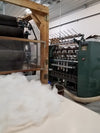We last left off with the wool ready to be taken to the mill. Let's back up a couple of steps and go back to shearer and exactly what he does. He places the sheep on it's hind end and cradles the animal between his two shins, head up and back, sometimes in back of the shearer's legs. This position actually relaxes the sheep (most of them) and allows the shearer to proceed with the process. If you've ever seen a barber give a buzz cut, this is very similar only the clippers are a lot bigger. The shearer starts at the top of the head and works his way down the sheep. Belly wool and short wool from the face area are tossed aside along with any particularly icky parts that are shorn off. This is the stuff that is typically composted or used as mulch.
The rest of the wool that comes off of the sheep is basically in one big "sheet" called a fleece. The really good, experienced hands can gather it up in a certain way and toss it all out onto a skirting table. It opens right up like a sheet blowing in the breeze and lands on the table. Skirting is what it's called when you run your hands through the wool removing any VM (vegetable matter), big pieces of hay and straw, small twigs, cockle burs or any other foreign matter that shouldn't be there. It can then be gathered or rolled up and put into a bag. The big operations use wool sacks and pack the wool down into them tightly. Someone is often inside the big bag tamping the wool down with their feet. In small operations like mine, we use garbage bags, bed sheets, pillow cases or paper lawn and leaf bags. I used to have a certain number of sheets I used for this purpose alone, but now I have too many sheep for that. I use paper lawn and leaf bags and pick them up on sale. They're inexpensive and can be composted. They also make great fire starters for the wood stove once they've served their purpose. I have some I've used for several years. They're easy to write on. You just have to make certain you cross off last year's info on the bag!
With the sheep in this position, now is a good time trim hooves and vaccinate before setting them back on all fours so they can head out for a bite to eat. It's at this point in a ewe's gestation cycle when the shepherd is happy to have the wool off so (s)he can see what's going on behind and under the sheep. Besides a big belly, there are other physical changes a sheep has when she's getting closer to lambing and for me, this is one of the immediate benefits of shearing. You know who looks close and who doesn't.
So the sheep have been sheared, their fleeces have been skirted and put into the proper storage bags. Now it's time to process wool!
